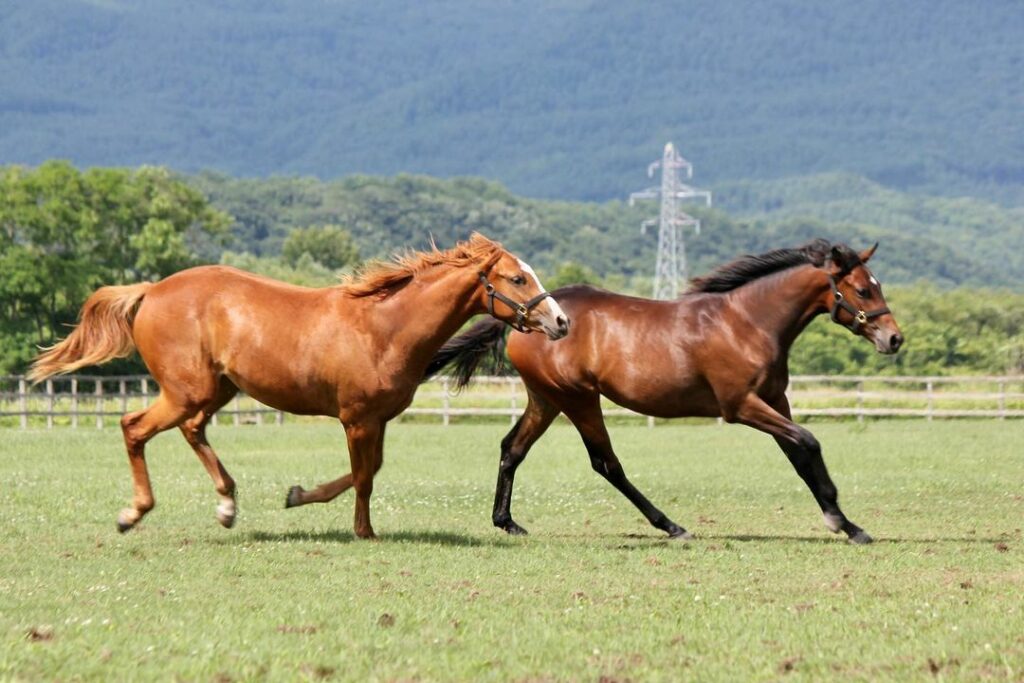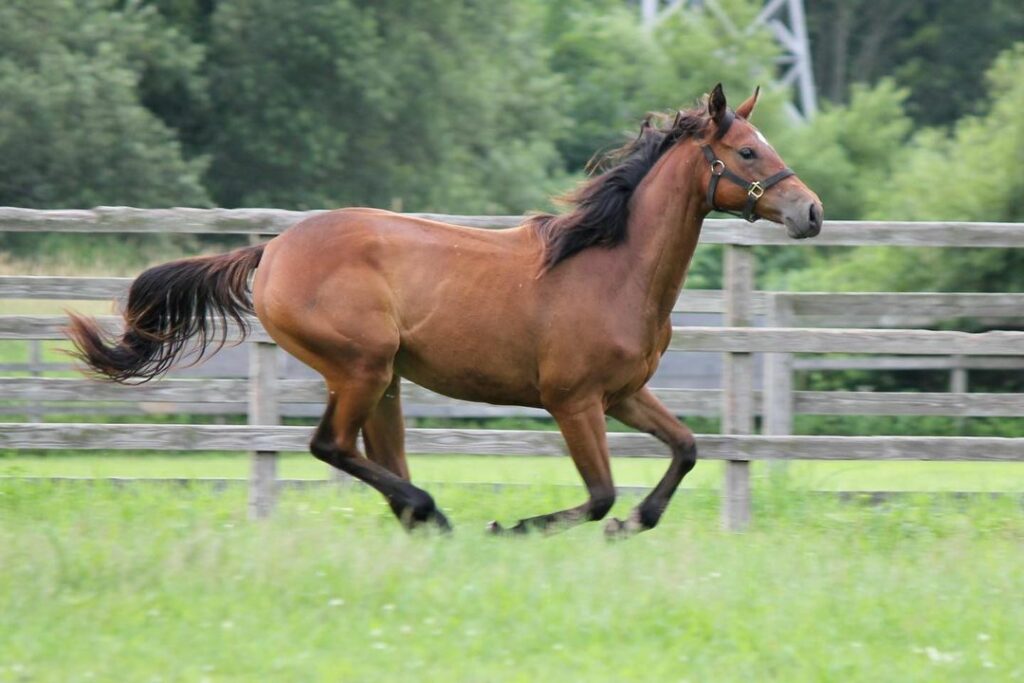
On average, horses can run between 25 and 30 miles per hour, which equates to 40 to 48 kilometers per hour. However, some horses are faster than others due to many factors. These factors include breed, genetics, anatomy, and training. Additionally, the horse’s age, sex, and health can also affect its speed.
Horse Speed Basics
Horses are known for their speed, agility, and grace and their speed of a horse can vary depending on various factors such as breed, age, training, and physical condition.
Horse Gaits
Horses have four natural gaits, which are the walk, trot, canter, and gallop. Each gait has a different speed and rhythm, and horses can switch between them depending on their speed and the terrain they are traversing.
- Walk: The walk is the slowest gait of a horse, with an average speed of 4 miles per hour (6.4 km/h). It is a four-beat gait, where each leg moves independently.
- Trot: The trot is a two-beat gait where the horse’s diagonal legs move together. It has an average speed of 8 to 12 miles per hour (12.8 to 19.3 km/h).
- Canter: The canter is a three-beat gait that is faster than the trot, with an average speed of 12 to 15 miles per hour (19.3 to 24.1 km/h).
- Gallop: The gallop is the fastest gait of a horse, with an average speed of 30 to 40 miles per hour (48 to 64 km/h). It is a four-beat gait where the horse’s legs move in a particular sequence.
Horse Racing
Horse racing is a popular sport that involves horses running at high speeds over a specified distance. The speed of a racehorse can vary depending on the type of race, distance, and breed of horse.
- Thoroughbred Racing: Thoroughbred racing is the most popular form of horse racing. These horses are bred for speed and agility and can run at an average speed of 40 to 45 miles per hour (64 to 72 km/h).
- Harness Racing: Harness racing involves horses pulling a two-wheeled cart called a sulky. These horses can run at an average speed of 30 miles per hour (48 km/h).

Factors Influencing Horse Speed
Horses are known for their speed, and various factors influence how fast they can run. Here are some of the most significant factors that affect a horse’s speed:
Breed
The breed of a horse can significantly impact its speed. For example, Thoroughbreds are known for their speed and agility, making them ideal for horse racing. On the other hand, draft horses, such as Clydesdales, are much larger and more muscular, making them slower but stronger.
Age
Age also plays a significant role in a horse’s speed. Younger horses tend to be faster and more agile, while older horses may have slower reflexes and reduced stamina. However, with proper training and care, horses of all ages can maintain their speed and agility.
Health and Fitness
A horse’s health and fitness are critical factors in determining its speed. Horses that are in good health and physical condition will be faster and more agile than those that are not. Proper nutrition, exercise, and rest are essential for maintaining a horse’s speed and overall health.
In conclusion, several factors influence a horse’s speed, including breed, age, and health and fitness. By understanding these factors, horse owners can help their horses reach their full potential and perform at their best.

Measuring Horse Speed
Measuring a horse’s speed is a fascinating topic that has been studied for centuries. There are several factors that can affect a horse’s speed, including breed, age, health, and training. Here are some methods used to measure horse speed:
Timing
Timing is one of the most common methods used to measure a horse’s speed. This can be done using a stopwatch or a specialised timing device that is triggered by the horse passing a certain point. The time taken to complete a specific distance is then used to calculate the horse’s speed.
Radar
Another method used to measure a horse’s speed is radar. This involves using a radar gun to measure the speed of the horse as it runs past the device. Radar is particularly useful for measuring a horse’s top speed, as it can capture the speed of the horse at its fastest point.
GPS
GPS technology can also be used to measure a horse’s speed. This involves attaching a GPS device to the horse’s saddle or bridle, which tracks the horse’s speed and distance travelled. This method is particularly useful for measuring a horse’s speed over long distances.

Horse Speed in Different Disciplines
Horse racing is one of the most popular disciplines where horse speed is of utmost importance. Thoroughbred horses are commonly used in racing, and they can run at a top speed of 44 mph. However, the speed of a horse in racing also depends on various factors such as the breed, terrain, and the horse’s conditioning.
In show jumping, the speed of a horse is also crucial. The horse must be fast enough to complete the course within the allotted time, but not too fast that it causes the horse to make mistakes. The speed in show jumping is typically between 350-375 meters per minute, which is equivalent to 1.15-1.23 meters per second.
In dressage, the focus is not on speed but on the horse’s movement and form. The horse must perform a series of movements at different gaits, including the walk, trot, and canter. The speed of the horse in dressage is not as important as its ability to execute the movements with precision and grace.
It’s worth noting that different disciplines require different speeds, and a horse’s speed can be influenced by various factors such as breed, conditioning, and terrain. Therefore, it’s important to consider these factors when evaluating a horse’s speed in a particular discipline.
Comparing Horse Speed to Other Animals
Horses are known for their impressive speed, but how do they compare to other animals? Let’s take a look at some of the fastest animals in the world and see how horses stack up.
Cheetahs
Cheetahs are often considered the fastest land animal, capable of reaching speeds of up to 70 miles per hour. While this is faster than most horses, cheetahs can only maintain this speed for short distances. In contrast, horses can maintain a speed of around 30 miles per hour for longer periods of time.
Greyhounds
Greyhounds are another animal known for their speed. These dogs can reach speeds of up to 45 miles per hour, making them faster than most horses. However, like cheetahs, greyhounds can only maintain this speed for short distances.
Peregrine Falcons
Peregrine falcons are the fastest birds in the world, capable of reaching speeds of up to 240 miles per hour when diving to catch prey. While horses are not as fast as peregrine falcons, they are still impressive in their own right.
Sailfish
Sailfish are some of the fastest fish in the ocean, capable of swimming at speeds of up to 68 miles per hour. While horses cannot swim, they are still faster than most land animals.
Overall, horses are impressive animals when it comes to speed. While they may not be the fastest animal in the world, they are certainly among the fastest on land.

Historical Perspective on Horse Speed
The speed of horses has fascinated humans for centuries. Horse racing dates back to ancient times, with the first recorded race taking place in Greece in 648 BC. However, it wasn’t until the 17th century that horse racing became a popular spectator sport in England.
In the early days of horse racing, the horses were not bred specifically for speed. Instead, they were simply the fastest horses available. As a result, the average speed of horses in races was much slower than it is today.
It wasn’t until the 18th century that horse breeders began to focus on breeding horses specifically for speed. This led to the development of the Thoroughbred, a breed known for its speed and agility. Thoroughbreds quickly became the dominant breed in horse racing, and their speed has continued to increase over the years.
Today, Thoroughbreds are the fastest horses in the world, with some horses capable of running at speeds of up to 45 miles per hour. However, other breeds such as Quarter Horses and Arabians are also known for their speed and agility, and can run at impressive speeds over shorter distances.
Overall, the speed of horses has increased significantly over the centuries, thanks to advances in breeding and training techniques. Horse racing remains a popular sport around the world, and the speed and athleticism of these magnificent animals continues to captivate audiences.
Future Trends in Horse Speed
With advancements in breeding techniques and training methods, it is reasonable to expect that horses will continue to get faster in the future. However, the extent to which this will occur is uncertain, as there are several factors that can limit the speed of horses.
One factor that may limit the speed of horses is their anatomy. Horses have evolved to run at high speeds, but there may be a limit to how fast they can run based on their physical structure. For example, the size and shape of a horse’s lungs, heart, and muscles can affect its ability to run at high speeds.
Another factor that may limit the speed of horses is the environment in which they live. Climate change and habitat loss can affect the availability of food and water, which can impact the health and performance of horses. Additionally, changes in land use and human activity can lead to increased competition for resources, which can also affect the speed and performance of horses.
Despite these limitations, there are several ways in which horses may continue to get faster in the future. For example, selective breeding can be used to produce horses with desirable traits, such as speed and endurance. Additionally, advances in training techniques and equipment can help horses to reach their full potential and perform at higher levels.
In conclusion, while there are limitations to how fast horses can run, it is likely that they will continue to get faster in the future due to advancements in breeding and training methods. However, it is important to consider the impact of environmental factors on the health and performance of horses, and to ensure that these factors are properly managed to support the continued success of these magnificent animals.
